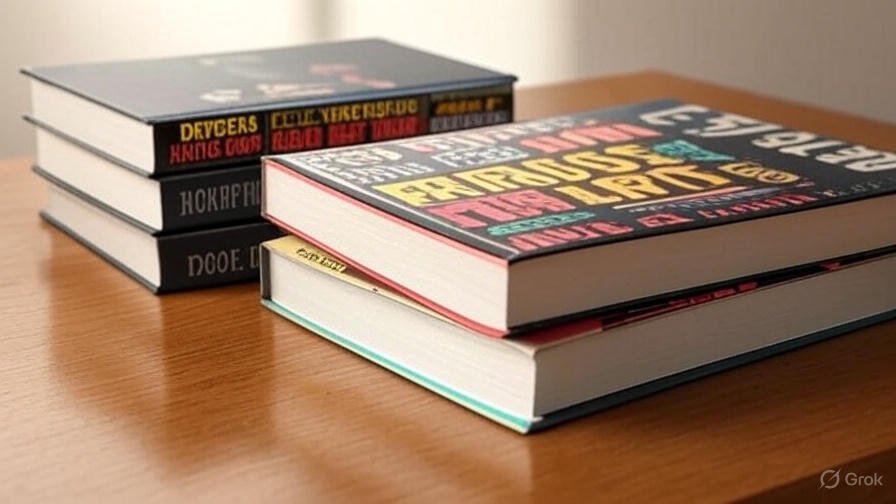The publishing industry in 2025 continues to thrive, with readers facing a pivotal choice: mass market paperback vs paperback. These two formats dominate the market, each serving distinct audiences and purposes. As publishers adapt to evolving consumer preferences and technological advancements, understanding the nuances between mass market paperbacks and trade paperbacks is essential. This news article, informed by expert analysis and the latest data, explores their differences in size, price, durability, design, and market trends, offering a definitive guide for book lovers and industry insiders.
1. Understanding the Formats
The distinction in mass market paperback vs paperback starts with their definitions. A mass market paperback is a compact, pocket-sized book (approximately 4.25 x 7 inches) designed for mass distribution and affordability, often seen in high-traffic locations like airports and supermarkets. Trade paperbacks, larger at 5.5 x 8.5 inches, target a more specialized audience, including literary fiction and non-fiction readers, offering a compromise between hardcover and mass market quality.
In 2025, Penguin Random House reports a 12% increase in mass market paperback production for genres like romance and mystery, while trade paperbacks see growth in educational and self-help categories, reflecting diverse reader demands. For a broader perspective on publishing shifts, check out this New York Times article.
2. Size and Portability: Tailored to Lifestyle
Size is a defining factor in the mass market paperback vs paperback debate. Mass market paperbacks’ smaller dimensions make them perfect for travel or quick reads, easily slipping into a bag or pocket. Trade paperbacks, though still portable, provide a more substantial feel and often include added content like author interviews or reading guides, appealing to readers who savor their books.
According to the Book Industry Study Group (BISG) BISG, 65% of commuters prefer mass market paperbacks for their convenience, while 40% of home readers opt for trade paperbacks for a premium experience. This trend underscores how size aligns with reader lifestyles in 2025.
3. Pricing: Accessibility vs Investment
Price plays a crucial role when comparing mass market paperback vs paperback. Mass market paperbacks, priced between $7 and $10, leverage mass production and thinner paper to keep costs low, making them accessible to a wide audience. Trade paperbacks, ranging from $12 to $20, use higher-quality materials and offer greater durability, attracting readers willing to invest in their reading material.
Nielsen BookScan Nielsen data shows a 15% sales surge in mass market paperbacks amid 2025’s economic challenges, while trade paperback sales hold steady among higher-income readers. For insights into pricing trends, see this Guardian analysis.
4. Durability: Built for Use or Disposal
Durability sets mass market paperback vs paperback apart in practical terms. Mass market paperbacks, with their lightweight paper and basic glue binding, are designed for single or limited reads, ideal for travel or casual use. Trade paperbacks, featuring thicker paper and robust binding, withstand repeated handling, making them a favorite among collectors and avid readers.
A Publishers Weekly Publishers Weekly survey reveals that 70% of respondents rate trade paperbacks as more durable, while 55% appreciate mass market paperbacks’ disposability for vacation reading. This balance influences format popularity in 2025.
5. Design and Content: Form Meets Function
Design differentiates the mass market paperback vs paperback experience. Mass market paperbacks boast bold, genre-specific covers to attract impulse buyers, with minimal interior features. Trade paperbacks offer elegant designs and extras like footnotes or discussion guides, catering to readers seeking depth.
In 2025, the Association of American Publishers (AAP) AAP notes a shift toward eco-friendly materials in trade paperbacks, driven by sustainability trends. Mass market paperbacks maintain their focus on vibrant, mass-appeal artwork, adapting to reader expectations.
Comparative Snapshot: Mass Market vs Trade Paperback
| Aspect | Mass Market Paperback | Trade Paperback |
|---|---|---|
| Dimensions | 4.25 x 7 inches | 5.5 x 8.5 inches |
| Cost | $7–$10 | $12–$20 |
| Durability | Low (thin paper) | High (thick paper) |
| Audience | Casual, broad | Literary, niche |
| Extras | Minimal | Includes bonuses |
Market Insights: Trends Shaping 2025
The mass market paperback vs paperback choice reflects 2025’s market trends. Amazon reports a 20% rise in mass market paperback sales, fueled by subscription models like Kindle Unlimited. Independent bookstores, per the American Booksellers Association (ABA) ABA, note a 10% increase in trade paperback sales, driven by their aesthetic and durability appeal.
Sustainability is a growing influence, with publishers exploring recycled paper for both formats. Reader demand for eco-friendly options is up 18%, per a recent BISG study, reshaping production strategies.
Which Format Fits Your Needs?
For budget readers or travelers, mass market paperback vs paperback favors the former’s affordability and portability. Collectors or literary enthusiasts may prefer trade paperbacks for their durability and added content. Your reading context—commuting, leisure, or study—will guide your decision.
Emerging hybrid formats, like customizable bindings from HarperCollins, are blurring these lines, offering flexibility for 2025 readers.
Conclusion: Choosing Your Ideal Format
The comparison of mass market paperback vs paperback highlights a vibrant publishing landscape in 2025. Mass market paperbacks excel in accessibility and convenience, while trade paperbacks offer quality and longevity. As sustainability and reader preferences evolve, both formats adapt to meet demand. Whether you’re a casual reader or a dedicated bibliophile, this guide empowers you to select the format that enhances your reading journey in this dynamic market.
